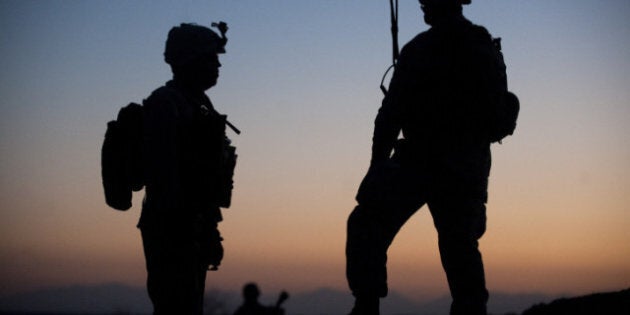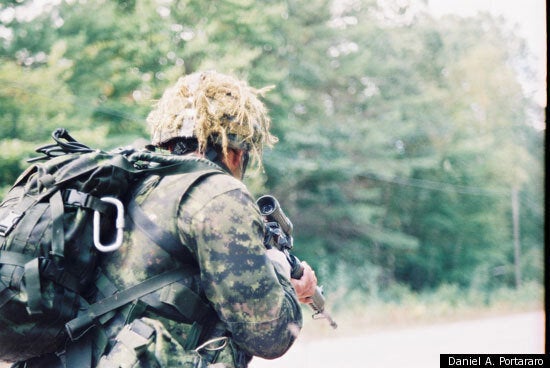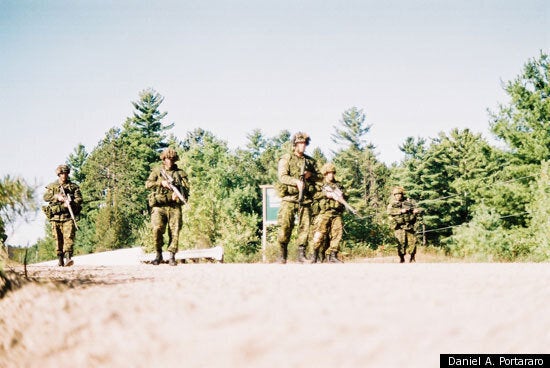

HuffPost contributor Daniel Portoraro spent a week with the Canadian Forces undergoing basic training. His unique perspective gave him a more personal insight into our soldiers' daily lives, and indeed into the broader debate over the future role of the military post-Afghanistan. This is part three of a four-part series, which will run every day until Thursday.
I'm driving back to CFB Petawawa. It's dark out, not even dawn, and my cold's getting worse. The town is still sleeping, but the base is full of life; it's an office that's awake before the markets even open.
Oh six hundred hours and I'm standing in a hangar-like room listening to a debriefing for the day's exercise. Paratrooping equipment lines one wall, fold up chairs on the the floor. The lieutenant's briefing is straight-forward, precise and safety conscience. But there's also a sense of it being relaxed; men don't have their backs straight, and some are sitting on the ground.
I leave the room, and make my way to the lot of the 3RCR building to wait for my ride. It comes in the form of a large, green transport truck. The corporal driving the vehicle seems kind and down to earth, and his lieutenant is sipping an energy drink. The corporal tells me about the various types of licenses that soldiers have to apply for to drive certain vehicles. And he doesn't just mean you have to get license X for vehicle X, and license Y for truck Y. In the Canadian Forces, one has to go through strenuous training, not only for different types of transport, but also for different types of cargo, whether it be troops, weaponry, supplies, or equipment. This corporal tells me he's authorized to drive any land vehicle in the army. He says this with a quiet sense of pride.
We drive along the road to the BIP, the boat inflation point. The sky is finally punctured by the morning sun as we pull up to the beach where there are other trucks and soldiers drinking coffee out of paper cups.
"Nicotine and caffeine," a soldier says, "that's how we stay awake." He's holding a steaming cup of coffee in one hand, a cigarette in the other. These men, for all the physical training they do, seem to smoke more than the kids in my modern poetry class. And they don't cough nearly as much. In fact, they don't seem to cough at all. I finish my smoke and toss it on the ground.
An officer calls out to me, "I don't want to sound like an asshole. But you better fucking pick that up." I'm surprised -- not at his language, swearing is as rampant in the forces as it is in frat houses. But it doesn't come of as violent, or ill-meaning -- and a feeling of dread passes over me. I don't want to hear a lecture about littering and the environment; I hoped to have left that in college. But I'm a stranger here, and it's a lieutenant who's speaking to me. So for the first time in my life (mother would be proud) I bend over and pick up the cigarette butt and toss it in a nearby garbage bag.
"Sorry about that," he says when I come back, "but everyone's gotta throw their butts away." I ask him why.
"When we're on the field, we can't leave our cigarette butts lying around, so we instill that mentality even when we're training."
I look at him quizzically.
"The way that it works is like this," he explains, "you're on patrol, and the rekkies (reconnaissance) say there's a patrol of 10 guys you're trying to find. You're on their trail, and if you come by some cigarette butts, you can tell, from how many there are, what their numbers are like, how high their supply lines are, and most importantly, how high their morale is. The more smokes you have, usually the higher your morale." He pauses and spits some dip out his mouth.
"A good smoker, when he does his laundry, finds a shit ton of cigarette butts in the machine. You gotta put them out, strip off the paper, and put the filter in your pockets. That's how you prevent the enemy from knowing more than he should."
I'm taken aback by this reasoning: It's so specific, so detailed. But as I continue to spend time with the Canadian Forces, I'm privy to a lot of this type of detail-oriented information. It's striking to see and hear exactly how much thought goes into everything the Forces do.

This mode of thought extends even into the hierarchy of the army. In platoons, there is an incredible overlapping of knowledge. After trying to explain to me how the chain of command works, something I have a hard time grasping, the soldiers I'm speaking to finally come up with a way to make it understandable to my civilian ears.
"Think of it as building a house," a sergeant tells me. "You have the contractor; he's the commanding officer (e.g. lieutenant), but he can't build the house without the electrician, the plumber or the carpenter. These three guys are kind of like NCOs (non-commissioned officers), like a sergeant. They're the ones with practical, real-world knowledge and expertise." However, unlike in building a house, NCOs also teach their commanding officers to do certain things; this overlapping of knowledge increases, not only the sense of camaraderie and teamwork, but also independence: Should something happen to the NCO trained to drive a LAV, the CO can take over if he needs to.
"You can also think about it as a family," another soldier tells me. "The lieutenant (the CO) is in charge of logistics. He organizes events, training, gets the wheels moving for the day. He's kind of like the father of the family. Then you have the warrant officer (WO) who is charge of discipline, and making sure things go according to schedule. The WO is kind of like the mother, taking care of the kids at home. And then you have the privates and corporals; they're the brothers and sisters."
But the feeling of family doesn't end here. Brotherhood in the Canadian Forces is something akin to that one would find in a fraternity. However, unlike the latter, the former does not exist due to allegiance to some false mythos. Rather, the sense of brotherhood exists because your fellow soldier is literally the man who is covering your back. This is referred to as "Fire Team Camaraderie" and is rampant through light infantry divisions. They never leave a man behind.
Not only will a team never leave a troop behind, but a Canadian soldier will never let himself be left behind. A corporal explains to me the difference between "hurt" and "injured."When a soldier is "hurt," it means his muscles might be sore. When he is "injured," it means he has something like a broken ankle.
"But," the corporal tells me, "even if a soldier's injured, he'll continue to go on. Mentally, he has to go on. He can't bear to be away from his boys. Take me for example," and he smiles mischievously, "I'm not supposed to be here on the field today. My arm's all screwed up. But I am. I have to go to surgery next week for it, but I'm not taking the time off." But when he says he's not taking the time off, he means it, because while this corporal isn't fast-casting today, he's nonetheless helping with everything on the training field, lifting heavy objects and the like.
For a commanding officer, there is a similar sense of teamwork: I'm told that in the world of a CO, the priorities are: mission, then men, then self. Every commanding officer has his 2IC which means second In command. A good 2IC is worth his weight in gold for the IC--the 2IC does everything in his power to lighten the load, to save time, and to make the CO's job easier. They are vital to the success of every fire team.
At the infantry level, the priorities of work are as follows: weapon (lifeline), kit (helps complete mission), food (energy keeps mission going), sleep. "If your weapon doesn't work, you might as well not be on the field," a soldier tells me bluntly.
"You go until you literally can't go on anymore," a sergeant explains, "and we do that even when it comes to things like sleep. In BT (basic training), you're forced to stay awake for three days, with a period of 'forced rest' of four hours sleep. After those four hours, you can go on another three days." Forced rest is when a commanding officer literally orders a soldier to rest, whether it's a comfortable zone or not: "It's time for yourself. Even if it's just for 20 minutes, it's for you to relax. All of this is a matter of conditioning the human body. We train for the worst so that we can deal with it when it comes, and we can excel in more comfortable climates."
Just before the last raft takes off for Green Beach (the starting point for today's exercise), the soldiers begin to clean the BIP (boat inflation point), making sure all the trash is gone and we're not leaving "information" behind.
I speak to some of the men from an assault group before they get into the water. I ask about the physical component to being a member of the Canadian Forces, and one of them jokingly tells me about the Iron Man competition they now do every year at CFB Petawawa. For civilians, the Iron Man competition is known as a near-superhuman test of force. For the Canadian Forces, it breaks the limit of what most can do. Carrying about 40 pounds of equipment (combat boots, combat pants, ruck-sack, etc.), participants go through a 32-kilometre run, followed by a four-kilometre portage, an eight-kilometre paddle along the Ottawa River, and finally, a six-kilometre sprint. Yes, sprint. This year's Iron Man Competition had six members of the Third Royal Canadian Regiment in the top 10, with first place taking five hours and 38 minutes to complete. The average soldier, carries about 97 pounds of equipment when on a field exercise. The men from assault platoons carry 140 pounds of equipment when FFO, that is, full fighting order.
When the men arrive at Green Beach, they prepare these 97 pounds of equipment in a forest just off the shore. The process takes them about 15, 20 minutes, and is performed in near-complete silence. They take apart their rifles, checking for water damage, and load live ammunition into them. Some even take advantage of MREs (meals ready to eat) that have been supplied for the exercise.
A myth that's been propagated by movies is that all food in the forces comes in the form of oversized tuna cans -- disgusting rations whose contents' taste verge on dog food. On base however, things are very different. Mess halls serve up meals that supersede those of a college dining hall in terms of quality, and at prices that make the latter look dining at the Ritz. During field exercises, soldiers are treated to packaged meals that come in cardboard boxes. Their contents generally include: two sandwiches, a piece of fruit, a bottle of water, a juice box, pudding, and some form of salad. And they're actually quite good, and contain all the nutritional requirements for both the physical and moral upkeep of a soldier. As for drinking, the Forces has mess halls for that as well, where a member of the CF can get a Bud Light for $2.50, a price that certainly beats what one pays at any bar in downtown Ottawa, happy hour or not. It's interesting to note that after two beers, one is automatically entitled to a free cab ride back home. It might seem like maternal caution, but when one thinks about it, every soldier is a huge investment. Better safe than sorry.

After having gone through a "dry rehearsal" (a rehearsal without live ammunition, which is meant to eliminate all doubt from the mission, a commanding officer tells me), the company I'm tailing prepares itself for the live version. They move stealthily through the forest. No one is talking, and the only sound is the cracking of branches under heavy boots. They come to a road, and one by one, with a soldier on either end covering them, hurry across in small clouds of dust. Their ballistic-proof sunglasses shine under a sun that's slowly drying their uniforms, drenched, from having somersaulted into the river.
Again, they regroup in a small forest, and when the platoon is reunited, march, single rank, onto the training ground. It's a large, gray clearing, surrounded by dead trees. Step by step, the soldiers cover their ground, firing at targets that pop-up. They take cover behind obstacles, dive into the dirt, all the while firing their heavy weapons. I tail them, mere meters separating me from their assault rifles. The air quickly smells of gunpowder, and their gunshots echo through the playground.
I'm about to pick up an empty round from the ground, and ask my accompanying sergeant if it's safe. He laughs and tells me that while the rounds are burning hot, they cool off after a few minutes. But still, I won't be able to take one home with me as a keepsake, he says. It's not because I'm a civilian; this rule applies to everyone in the Forces. Under no circumstances is a soldier to remove bullets, live or dry, from the training ground. The rationale behind this, the sergeant tells me, is to avoid a slippery slope: a soldier may bring dead ammunition home with him one day as a keepsake, which may eventually lead him to bringing live ammo home. It's a safety measure, and after every exercise, the commanding officers stress to the participants not to take ammo with them. There are what are called "amnesty boxes" strewn about the base; boxes where soldiers who haven't listened to this rule, can drop off bullets anonymously, and without repercussion. It's an honor system which is followed, the sergeant tells me.
After lunch, I'm driven back to base. My chauffeur is a talkative corporal, and when I ask him how he feels the greater public views the Canadian Forces, he doesn't speak with disdain, but rather, with understanding:
"A lot of people don't know what goes on in the woodwork of the Forces," he tells me. "In a sense, it's good that Afghanistan happened; it allowed us to show Canadians what we do, and what their taxes are paying for. There's a lot that goes on here. And usually, if there's a sense of animosity against the army, it's because a lot of people don't know much about us."
Back in my motel room, I think about not only what the corporal said, but what everyone, from private to major, told me over the past few days. And the young man is right: the greater part of civilians don't know much about the army besides what they see on TV. It's a great deal more than bullets being fired across the sandy banks of Afghanistan; it's a world of its own, one that keeps "ours" moving forward. But with the Canadian troops in Kandahar being brought back home, there's been a call to cutback spending by this world within a world; we don't need to invest as much in the Forces, people are saying. In light of this, I decided to speak with the base commander of CFB Petawawa, Colonel Simon Hetherington, and ask him, what was the next step for our men in uniform?